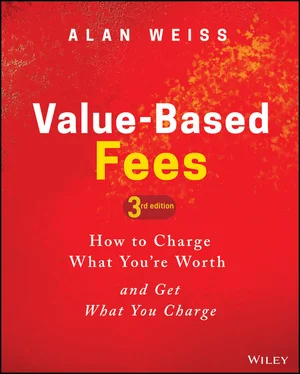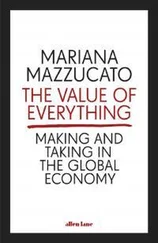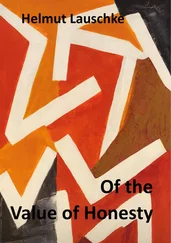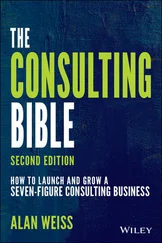This is why patience in formulating the right relationship is more important than attempting to make a “fast sale.” The former is a partnership where fees are academic; the latter is a unilateral benefit where fees are often the main point of contention.
The buyer's commitment to outcomes and to his or her role in the partnership being formed to reach those outcomes is the key determinant of high fees. Buyers who are too willing to go along with your recommendations are as potentially fatal as those who dig in their heels after you've said hello.
CRITICAL STEPS FOR BUYER COMMITMENT
It's worth repeating here briefly the sequence of events in the consulting business acquisition process that engenders the highest-quality commitment; the first three are shown in the graphic in Figure 1.3:
Shared Values: Those common business beliefs that will allow you to work effectively with the prospect—for example, a mutual antipathy for downsizing or a common belief in the importance of ongoing employee feedback
Relationship: That level of a trusting interaction in which you and the buyer are comfortable with each other, can be honest (even in disagreeing), and share insights and assistance with each other on a mutual basis
Conceptual Agreement: Agreement between you and the buyer on the objectives for the project, expressed as business outcomes; metrics, measures of progress toward those objectives; and value, the buyer's stipulation of how he or she and the organization will be better off as a result of those objectives being met

Figure 1.3 Consulting Business Acquisition Sequence
These three critical steps, each dependent on the prior step being successfully in place and addressed as we proceed, will garner buyer commitment. The absence of conceptual agreement will result in either a lost sale or a lousy sale (and the latter is often more damaging than the former).
Fees are dependent on buyer commitment well before a proposal is ever tendered. Note that fees are not even on my chart .
THE BUOYANCY OF BRANDS: HOW BRANDS HELP FEES
The second book in this Ultimate Consultant Series is dedicated to branding for consultants. One of the key reasons for effective branding is to enhance fees.
Fees are (or should be) based on value. That value is always in the eye of the beholder—in our case, the economic buyer. Hence the more value conveyed to that buyer by the most powerful means, the less downward pressure on fees. Effective branding actually creates a fee “buoyancy.”
There is actually one thing better than a buyer impressed by you and respecting you on sight, and that is the buyer impressed by you and respecting you before ever laying eyes on you.
No CEO ever said, “Get McKinsey in here,” when strategy work was needed, then followed up by saying, “I think they're too expensive.” As they say in the Ferrari showroom when someone asks about gas mileage or insurance costs, “If that's your concern, you really shouldn't be here.”
Ferrari is a brand that evokes certain immediate understandings on the part of the potential individual buyer:
High cost
Top status
High maintenance
High insurance
High repair costs
Unique image
Personal ego needs met 5
You know those things going in, and they are not points for discussion when dealing with a salesperson.
Similarly, McKinsey is a brand that evokes certain immediate understandings on the part of the potential corporate buyer:
High cost (fees will not be negotiable)
Top status (no one can say we're giving this short shrift)
High maintenance (a lot of junior partners will appear)
High insurance (the board can't complain about quality of the help)
High repair costs (they will recommend tough interventions)
Unique image (the cachet alone will raise expectations)
Personal ego needs met (only the best for the best)
You get my point. The mere power of a brand is sufficient to overcome any resistance to fees and, in fact, often elevates fees merely by dint of association with such brand images as quality, reputation, client history, and media attention.
There is no brand as powerful as your name , although strong company brands can also serve quite well. When a potential client says, “Get me Jane Jones” or “Get me the Teambuilder,” that client is articulating a clear imperative: Don't go shopping, don't compare prices, and don't issue a request for proposals; just get me that person I've heard so much about. (That is far superior to the buyer saying, “Get me a great leadership consultant” and your name is one of several in the hat.)
Brands create an upward expectation of both quality and commensurate fees. No one expects an outstanding person to come cheap. You usually have to convince the buyer of that quality through careful relationship building. But a strong brand shortcuts that process considerably. The relationship building still needs to be done (for reasons of commitment, as noted earlier), but the time required is significantly reduced. The buyer wants to be a partner, wants to follow your suggestions, and wants to participate because your credibility has preceded you .
Brands are accelerators of credibility and therefore of relationships. They immediately justify higher fees in the mind of the buyer, and that is the only mind that counts on that matter. Brands are expressions of uniform quality. The ultimate brand for most solo consultants is their name, as in: “Get me Joan James.”
It's not the intent of this book to explore how to create a brand. 6 However, it is vital to understand brand importance in the fee-setting process. Like bank loans being hard to acquire when you need them and easy to obtain when you no longer need them, high fees are most difficult when no one has ever heard of you and you desperately need the income and easiest when you're well known and business is rolling in.
Alanism: A brand is how people think of you when you’re not around.
The crime here is that many successful consultants either don't bother to use their past success to create effective brands or have created brands that they don't properly leverage for higher fees. Tom Clancy had never written a book nearly as good as his original, The Hunt for Red October, but he's certainly been paid far more for every subsequent work than for that first effort (and the writers now supporting his brand long after his death). He had been a smart marketer and a hugely successful “brand” (as James Patterson, who's sold a trillion books, seldom writes his own anymore but uses a “co-author”).
Brands create higher fees. And higher fees enable you to solidify the credibility of your brand. That's a great cycle.
Many consultants take the position (out of arrogance or ignorance) of “Let me show you how I'm going to improve things around here.” The success is the consultant's, a sort of largesse provided for the lucky client. There is a certain power in being “the expert” without whom all goes to hell, but there is a huge risk, although not the one that might be apparent.
The apparent risk is that the client might not benefit as desired or, heaven forbid, might actually suffer a reversal of fortune. Remember the physician's sage credo, “First, do no harm.” It's no accident that large consulting firms are being sued right and left in this litigious society. They have not “delivered” the desired results.
Читать дальше













